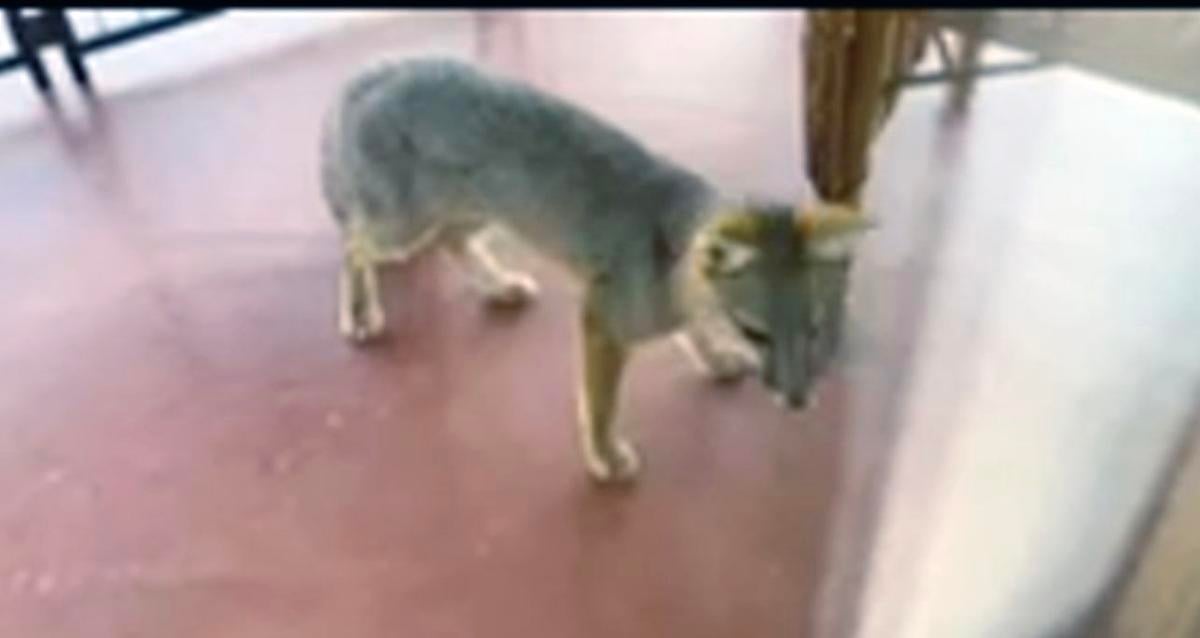Rabies is suspected in a gray fox that was filmed acting strangely on the patio of an east side home on Thursday, the fifth such case in the Tucson area in the past two months.
The Arizona Game and Fish Department is searching for the fox in the area of Agua Caliente Park after it was reported by a woman at a house on East Chukut Trail, about a mile and a half northeast of the park.
The gray fox chewed patio furniture and tried to get into a house near Agua Caliente Park on Thursday. State wildlife officials say anyone who sees the fox should avoid it and immediately report the sighting by calling the 24-hour hotline at 623-236-7201.
State wildlife officials consider the fox a “potential threat to public safety,” said department spokesman Mark Hart.
The cell phone video released by Game and Fish Thursday night shows the animal in broad daylight repetitively gnawing on wooden patio furniture at the home.
Hart said the fox was also seen pacing on the patio, biting the door trim and screens and trying to get into the house through a window, even though it could see the woman and her dog inside.
“Foxes would normally avoid both,” he said.
Anyone who sees the fox should avoid it and immediately report the sighting to Game and Fish by calling the department’s 24-hour dispatch center at 623-236-7201.
This marks the fourth incident on the east side of Tucson since late November involving an animal that appeared to be in the late stages of rabies.
The only case confirmed by a post-mortem test so far was a bobcat that attacked a woman in her carport off east Redington Pass Road and was quickly captured and killed by authorities on Nov. 27.
The animals were not recovered to be tested for rabies in the other two east side cases: one on Dec. 27, when a gray fox that bit one person and tried to attack another at the Molino Basin campground in the Catalina Mountains; the other on Jan. 21, when a bobcat bit and scratched a man on Cactus Forest Drive in the Rincon Mountain District of Saguaro National Park.
Rabies is also likely but never confirmed in a case of a skunk that bit a man and chased several other people at the Proctor Trailhead in Madera Canyon on Jan. 13.
The viral disease transmitted through saliva is most commonly carried by bats, foxes and skunks. It is almost always fatal after the onset of symptoms, which include unsteady movements, disorientation, extreme thirst, excessive salivation and aggression.
After the Jan. 21 bobcat attack, Saguaro National Park issued a warning about rabies, citing reports of unusual behavior by foxes and raccoons and the discovery of several fox carcasses in the park.
Meanwhile, instinct, not illness, is the suspected cause of a javelina attack early Thursday morning at a city park near Glenn Street and Country Club Road.
Hart said a 64-year-old woman was walking her dog in La Madera Park at 4:15 a.m. when she surprised a group of javelinas.
One of the animals charged, most likely in response to what it perceived as a predator, he said. “Javelinas can’t distinguish between a dog and a coyote.”
Hart said the woman was treated for bites on the ankle and the arm. As a precaution, she was also treated for rabies.
A small neighborhood park in the middle of Tucson might seem like an odd place to encounter desert wildlife, but Hart said javelinas and other animals do make their way into the urban core, often using washes to travel from place to place.
The Sam Hughes Neighborhood and other residential areas west of El Con Center routinely have issues with javelinas, he said. “If they can find food, water and/or shelter, they stay.”





